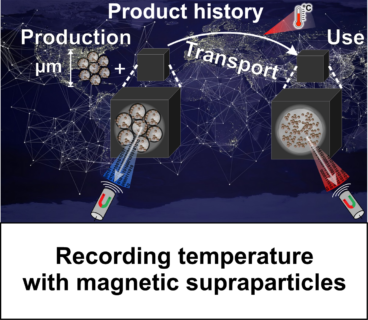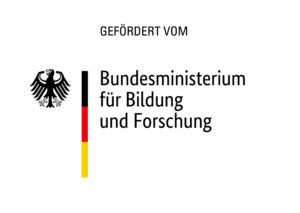Nano-Rust: Smart Additive for Autonomous Temperature Control

Temperature matters
The right temperature ensures the success of technical processes, the quality of food and medicines, or affects the lifetime of electronic components and batteries. Temperature indicators enable to detect (un)desired temperature exposures and irreversibly record them by changing their signal for a readout at any later time. Of particular interest are small-sized temperature indicators that can be easily integrated into any arbitrary object and subsequently monitor the objects’ temperature history autonomously, i.e. without power supply. Accordingly, the indicators’ signal readout permits to verify successful bonding processes, to uncover temperature peaks in global supply chains, or to localize hot spots in electronic devices.
Prof. Dr. Karl Mandel (Professorship for Inorganic Chemistry) and his research group have succeeded in developing a new type of temperature indicator in the form of a micrometer-sized particle, which differs from previously established, mostly optical indicators mainly due to its innovative magnetic readout method. The results of the research work have now been published in the renowned journal Advanced Materials (https://doi.org/10.1002/adma.202202683). The research was funded by the German Federal Ministry of Education and Research (BMBF) as part of the NanoMatFutur project NANO-ID (Grant No. 03XP0149) and by doctoral scholarships from the German Federal Environmental Foundation (DBU) for the two first authors Jakob Reichstein and Stephan Müssig.
Smart Rust
The central component of the new temperature indicator is rust, a mostly undesirable product of the reaction of iron or steel with acids or oxygen in the air. But rust, also known as iron oxide, offers enormous, previously uncovered potential. The FAU researchers are exploiting this potential with the help of nanotechnology. For the fabrication of the temperature indicators, initially tiny rust particles, so-called iron oxide nanoparticles, are produced. These are further processed together with commercial polymers into larger, so-called nanocomposite particles. In the final process step, many hundreds of nanocomposite particles are assembled via a spray-drying process into microparticles (1-20 micrometer), so-called supraparticles. The utilized spray-drying process is industrially established for the production of milk powder, for example, and is therefore highly scalable.
The resulting spherical supraparticles exhibit a complex, multi-hierarchical nanoarchitecture. In this, the rust particles act as magnetic signal carriers and the polymers as temperature-sensitive components. Together, the two components generate the temperature-indicator functionality, which works as follows:
The magnetic signal from the supraparticles is dominated by the distance-dependent interaction of the iron oxide nanoparticles. Short-term temperature increases (temperature peaks) cause a change in the nanoarchitecture of the supraparticles. This structural rearrangement is initiated by the polymer used and leads to a reduction in the spacing between the iron oxide nanoparticles. Thereby, the interaction between the magnetic nanoparticles and, consequently, the magnetic signal of the supraparticles are altered.
“The magnetic signal change is gradual and irreversible. Thus, the temperature-indicator supraparticles are able to indicate the maximum temperature reached in their material history,” says Jakob Reichstein, one of the two first authors of the publication.
Small size and cost efficient
The decisive advantages of the new temperature indicator supraparticles are, in addition to their flexible applicability granted by their small size and the use of cost‑effective and readily available materials, their modular design and their magnetic readout process. The modular design of the supraparticles allows to tailor the indicator properties, for instance sensitivity, working range and response time, in three process steps toward a particular application. In general, the response time of the temperature indicators ranges from seconds to minutes. Their operating range extends from approximately 40-170 °C.
“In addition, the magnetic readout method of the supraparticles using magnetic particle spectroscopy (MPS) deserves special mention. MPS makes it possible to read out the stored information of the temperature indicators even when the particles are applied in the bulk, that is the depth, of a dark object or behind an opaque coating,” explains Stephan Müssig, second first author of the publication. “These applications are hardly addressed by established optical temperature indicators,” Müssig adds. The readout process itself takes only a few milliseconds, is contactless and can be performed without special training.
“The combination of smart magnetic supraparticles (smart rust) and MPS, represents an attractive future technology to connect the analog world of materials with the digital world and thus realize important transformation processes. Therefore, this technology will continue to be the focus of my research in the coming years,” concludes Prof. Karl Mandel.
Further information
Original publication: „Recording Temperature with Magnetic Supraparticles”, https://doi.org/10.1002/adma.202202683
Contact
Prof. Dr. Karl Mandel
Professor for Inorganic Chemistry
karl.mandel@fau.de
Jakob Reichstein
jakob.reichstein@fau.de
Stephan Müssig
stephan.müssig@fau.de
Funding organizations


